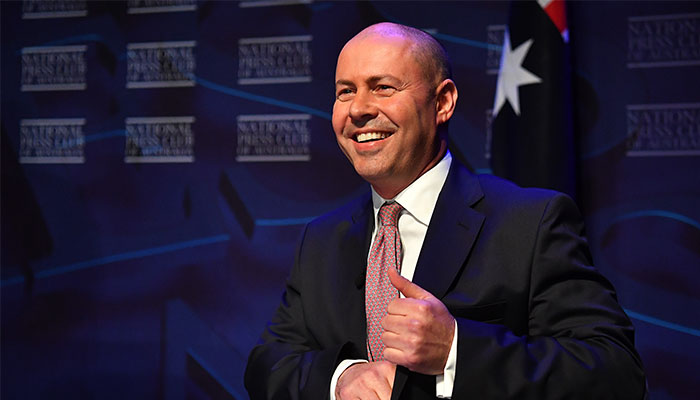Australia’s economic recovery has been remarkable. Just over a year ago, as COVID-19 started to circulate globally, Treasurer Josh Frydenberg noted we were “staring into the economic abyss”.

Splurge: From economic 'abyss' to spending spree, Treasurer Josh Frydenberg unleashed wide-ranging funding boosts to childcare, aged care, disability and mental health services in this week's budget.
The level of output plunged by 7 per cent, unemployment rose to 7.5 per cent and consumer confidence fell sharply.
The Reserve Bank and government responded with extraordinary policies, including huge funding to the financial system and for the JobKeeper and JobSeeker programs to protect business and household livelihoods. These policies injected around 10 per cent of GDP into the financial sector and economy during 2020.
While costly, this aggressive stance succeeded in stabilising confidence and underpinning a strong recovery. The level of output is now back around its pre-pandemic level and the 2021/22 budget projects the economy will grow at an above-trend pace in coming years.
The unemployment rate has fallen back to 5.6 per cent compared with 5.1 per cent pre-COVID, though the degree of labour slack is larger if one takes account of workers who want more hours.
With the worst of the crisis seemingly now behind us, the challenge for the budget is how to build on this success.
Spend, not save
Against this background, and in a marked departure from its previous stance, the government has eschewed faster deficit consolidation to instead drive the economy towards ‘full’ employment. That would be an unemployment rate around 4.5 per cent – a level not achieved since the Global Financial Crisis.
To that end, the budget redirects some of the savings from the ending of the (temporary) JobKeeper and JobSeeker programs to markedly increase (permanent) spending in other areas. It also prolongs the low- and middle-class income tax offset by a year and extends some business tax incentives.
The boost to spending on a permanent basis in aged care, mental health, disability, housing and childcare subsidies to address a cyclical employment issue risks locking in deficits far into the future .
Consequently, after hitting almost 8 per cent of GDP last year, the budget deficit is still projected at 5 per cent of GDP this year and is projected to remain in deficit every year for at least the next decade.
But using tax and spending policies to boost employment is not without risk. Much of the current underemployed labour reflects ongoing coronavirus-related restrictions affecting industries linked to foreign travel, international students, new migrant needs and hospitality.
- One-third of backyard soil unsafe to grow vegies: study
- Please explain: How will the COVID-19 pandemic end?
Jobs in these industries depend more on our international border policy (projected to open only gradually from mid-2022) and the vaccination program (optimistically forecast to be completed this year) than demand stimulus measures.
The boost to spending on a permanent basis in aged care, mental health, disability, housing and childcare subsidies to address a cyclical employment issue risks locking in deficits far into the future when stimulus is no longer needed.

Windfall: Many sectors received a funding boost in this week's budget including $1.2 billion for digital technologies.
Indeed, the spending-to-GDP ratio is projected at around 2 percentage points higher every year over the forward estimates compared with its pre-COVID level in 2018/19 (when it was 24.5 per cent).
Perilous productivity gains
The medium-term priority for Australia is to lift output per hour worked, which is known as ‘productivity’. Productivity growth is the key to sustainably raising real (after-inflation) wages and employment, yet its pace has been gradually declining for years.
The budget makes a down-payment in a few areas, allocating $1.2 billion for digital technologies, introducing a special tax regime for some patents, and boosted funding for apprenticeships and for public infrastructure.
But the scope and nature of the policy needs to boost productivity – outlined in reports from the Productivity Commission – go well beyond these efforts.
They include better skills training to prepare for upcoming technologies, enhancing competition to drive innovation and the adoption of technology by private firms, and improvements in the efficiency of public activities.
The budget projects that productivity growth will rise over the next decade towards its 30-year average, though there is no narrative on what underpins that trend. Tellingly, real wages are not projected to increase for years.
Debt levels rise
Looming over these near- and medium-term issues is the rapid rise in public debt. Net debt is forecast to rise from 19 per cent of GDP ($374 billion) in June 2019 to reach 41 per cent ($981 billion) by June 2025, with little indication of a medium-term budget repair strategy.
While low interest rates (for now) have enabled servicing costs to remain contained as debt has increased, the burden on future generations is rising (around half of public debt is held by foreigners).

Splurge now, pay later: this week's budget spending spree will drive up future debt says Professor of Economics David Orsmond (pictured).
That unfavourable debt projection should support a laser-like focus on whether existing spending and tax policies meet a rigorous cost-benefit threshold in terms of their ‘bang-for-buck’ in supporting economic growth and inclusiveness, while implementing a wide-ranging plan to boost productivity and the level of GDP to reduce the debt/GDP burden.
In the end, while difficult given the range of stakeholders and interests, wide-ranging policies to accelerate productivity growth through more knowledge, skills, investment and efficiency remain the best way to sustainably support wages growth and jobs, social and other budget spending, and our standards of living more generally.
David Orsmond is Professor of Economics at the Macquarie Business School. He previously spent 25 years working at the Reserve Bank of Australia and the International Monetary Fund.



